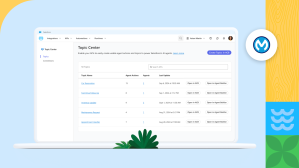MuleSoft today announced a comprehensive set of integration solutions that enable developers and admins to easily integrate structured and unstructured data from their CRM and external systems to ground AI agents and assistants in trusted data. Using these integrations, companies can also leverage the full power of Salesforce Data Cloud and Agentforce, personalizing experiences, augmenting employee workloads at scale, building deeper customer relationships, and ultimately, driving revenue.
Admins can now directly access MuleSoft, Salesforce, and Heroku APIs when building AI agents and assistants, connect knowledge sources to Data Cloud, and use out-of-the-box connectors to integrate their workflows to common systems and apps. Developers can create custom topics that define how an AI agent performs work. Additionally, they can build and manage AI agents outside the Salesforce environment through MuleSoft AI Chain, an open-source project built to connect and orchestrate LLMs, vector databases, and APIs in a unified environment.
Why it’s relevant: Customers increasingly expect quick and personalized responses to their service requests. To deliver on that expectation, companies must have ready access to every one of their data sources — and be able to put it to use with workforce-scaling AI agents and assistants. However, 95% of IT leaders still say integration issues are impeding AI adoption, leaving a gap between the technology companies need to meet customer expectations and what they can achieve.
Zoom in: MuleSoft’s integration, automation, and API management solutions help companies integrate their data to better leverage AI agents and assistants both inside and outside of Salesforce:
- Low-Code Integration for Flow enables admins to use out-of-the-box connectors directly within Flow Builder to securely access and use org-to-org and third-party data in their workflows. For example, admins can build a workflow that authorizes an autonomous sales agent to create an invoice in Quickbooks whenever a new order is updated.
- Salesforce API Catalog provides a single repository of APIs from Salesforce, MuleSoft, and Heroku embedded directly in Salesforce. Admins can use these APIs to create new topics and actions to improve the skills of an AI Agent. For example, admins can create an inventory topic leveraging integrations built with SAP.
- MuleSoft Direct for Data Cloud lets users easily find and deploy pre-built integrations to connect information from sources like Google Drive, Microsoft SharePoint, Confluence, and web pages to Data Cloud, directly from Salesforce. For example, admins can connect their product specifications, internal FAQs, and internal wikis into Data Cloud, allowing organizational knowledge in these sources to be used for grounding AI prompts within Service Cloud for faster, more personalized customer service responses.
- MuleSoft Topic Center allows developers to publish agent topics or groupings of specific information or skills that can be actioned with Agentforce Agents. The topics are created from integrations to various third-party systems that contextualize the response of Agentforce Agents, increasing their effectiveness. For example, developers can create a hardware device topic to assess whether an employee should have their laptop replaced, adding asset management and fulfillment APIs so the Agent learns the hardware replacement policy and how to place an order.
- MuleSoft AI Chain, an open-source initiative, provides seamless interaction with LLMs, vector databases, and APIs, empowering developers to build their own agent or copilot. For instance, a MuleSoft AI Chain connector can be used to connect and orchestrate Jira to multiple LLMs, resulting in an agent that can enhance the diagnosis of new or updated bugs. The agent can summarize the problem, suggest next steps, and gauge the customer’s sentiment from the existing conversation.
Salesforce perspective: “As organizations incorporate AI agents and assistants into their processes, having a simple approach to integrating their core systems and applications with LLMs is critical. With MuleSoft’s latest innovations, we are setting the stage for scalable, context-aware AI that empowers every team across the enterprise to build a foundation for AI.” – Andrew Comstock, VP, Product Management, MuleSoft
With MuleSoft’s latest innovations, we are setting the stage for scalable, context-aware AI that empowers every team across the enterprise to build a foundation for AI.
Andrew Comstock, VP, Product Management, MuleSoft
Customer perspective: “MuleSoft’s robust Integration capabilities have empowered us to quickly and securely connect data and applications to power our business initiatives. We have adopted an API-led data connectivity approach to increase interoperability and to facilitate dealer and internal interactions.” – Matthew Randall, Head of Software Development and Integration, Aston Martin Lagonda Ltd.
Availability:
- Low-Code Integration in Salesforce Flow is currently in pilot and will be generally available in the first quarter of calendar year 2025.
- MuleSoft Direct For Data Cloud will be in beta in the third quarter of 2024.
- Salesforce API Catalog will be generally available in the first quarter of 2025.
- MuleSoft Topic Center will be generally available in the first quarter of 2025.
- MuleSoft AI Chain will be generally available in the third quarter of 2024.
Explore more:
- Learn more about these innovations and watch Dreamforce sessions on Salesforce +, Dreamforce 2 U:MuleSoft, and Dreamforce 2 U: MuleSoft EMEA
- Read more about AI-Powered Composability with MuleSoft
Any unreleased services or features referenced here are not currently available and may not be delivered on time or at all. Customers should make their purchase decisions based upon features that are currently available.


